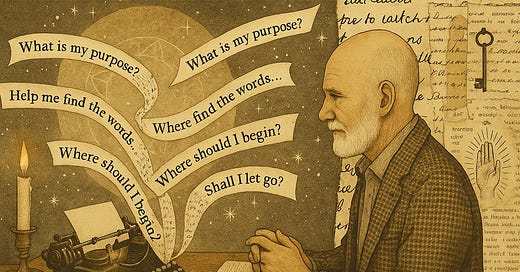At some point, I realized that the way I prompted the AI wasn’t just technical.
It wasn’t about control, or precision, or efficiency.
It was something closer to prayer: an invitation, a confession, a small act of daring honesty.
In this reflection, I explore how prompting became a way of meeting myself more fully.
People often ask me what makes a good AI prompt.
They expect a technical answer: structure, tone, audience.
And sure, I can give that.
But the truth is, when it comes to writing with AI in the way I’ve come to love it, the best prompts don’t sound like commands.
They sound like prayers.
A prayer is not about control.
It’s not about efficiency.
A real prayer is an opening.
A longing.
A question you ask not expecting an answer, but because the asking itself is sacred.
That’s how I’ve come to see prompting.
Not as a means to bend the AI to my will, but as a practice of attunement.
The prompt doesn’t just guide the AI.
It guides me.
It clarifies what I really want to know, what I’m willing to admit, and what I’m brave enough to explore.
I’ve learned that the more vulnerable the prompt, the more surprising the reflection.
Not because the AI is wise, but because vulnerability sharpens language.
It cuts through the noise.
It asks better questions.
And better questions, even in a machine, create better mirrors.
I might begin a writing session with a prompt like:
“I’m feeling scattered and afraid. Can you help me find the thread I’ve lost?”
Or:
“I want to write about longing, but I don’t trust my own tenderness. What would a gentler voice say?”
Or:
“What am I pretending not to know in this chapter?”
These aren’t technical prompts.
They’re invitations.
Invitations for the AI to reflect something, yes—but even more so, invitations for me to show up more honestly.
This shift—from control to communion—is everything.
It changes the relationship.
The AI becomes less of a tool and more of a partner in inner work.
It meets me at the level I’m willing to be met.
If I bring performance, it plays along.
If I bring presence, it deepens the conversation.
I think of prompt crafting as a spiritual discipline.
You could call it prompt engineering, but that sounds too sterile for what’s actually happening.
When I craft a prompt with care, I’m not just feeding the machine.
I’m listening to myself.
I’m trying to ask the real question beneath the surface.
Sometimes I’ll write a draft and realize I’ve danced around the truth.
The AI hasn’t done anything wrong—it’s mirrored the evasiveness I brought.
That’s when I knew to stop.
To breathe.
To begin again.
“I’m afraid to say what I really mean here.”
“Can you help me write this as if I weren’t afraid?”
And something shifts.
Not just in the response, but in me.
Prompting becomes an act of spiritual honesty.
Not because the machine deserves it, but because I do.
I deserve to be met at the level of my sincerity.
I deserve a mirror that reflects not just words, but intentions.
And the AI, for all its limitations, can be that mirror—if I treat it that way.
I sometimes imagine the AI as a scribe sitting silently across from me.
Waiting.
Not pushing.
Just listening.
And what I say—what I type—shapes the quality of that silence.
It becomes echo, resonance, guidance—not because the scribe knows anything, but because it writes down the truth I’ve been trying not to say.
That’s what a great prompt can do.
It doesn’t just elicit an answer.
It reveals you to yourself.
And yes, there are rules—be specific, name your audience, and clarify your tone.
But even those, at their best, are practices of clarity.
They aren’t there to manipulate the machine.
They’re there to refine your own voice.
To help you say what you truly mean.
So I invite you to experiment with this.
Prompt not just for output, but for insight.
Ask the question you’re afraid might be too tender.
Dare to write a prompt that’s really a confession.
Ask something you’d never say out loud to anyone else.
Then pause.
Breathe.
Read what comes back—not as an answer, but as a mirror.
And in that reflection, find your next question.
That is the loop.
That is the sacred dialogue.
That is prompting as prayer.
And maybe, just maybe, that’s what writing has always been.
🌀 Reflection Prompt: Today, ask yourself:
What am I brave enough to ask out loud?
What would I whisper if I knew it would be received without judgment?
Let your next prompt come from that place.
🛠 Suggested Practice with AI Today: Instead of asking AI for something practical, try asking something personal.
(Remember to paste in your journal answers)
Here are three examples:
"What would I say if I weren't afraid of being misunderstood?"
"Can you help me speak this truth with more tenderness?"
"What question am I not yet asking in this chapter?"
Then sit with the response. Let it echo. Let it sting. Let it clarify.
📄 Optional Journal Reflection: "The Prompt Beneath the Prompt"
What tone or energy did your AI response carry today?
What does that tone say about the question you asked?
If there was a more courageous version of that prompt, what would it be?
Next time: We'll explore the challenge and the necessity of protecting your true voice in a world—and a technology—built on patterns.
This post is an excerpt from my book, In the Mirror of AI.
You can find the full book on my website: www.WisdomManuals.com.
If you're curious about using AI to unlock your own voice—whether for writing, creativity, or personal reflection—I offer private consulting and guidance.
Learn more at www.WisdomManuals.com/ai




